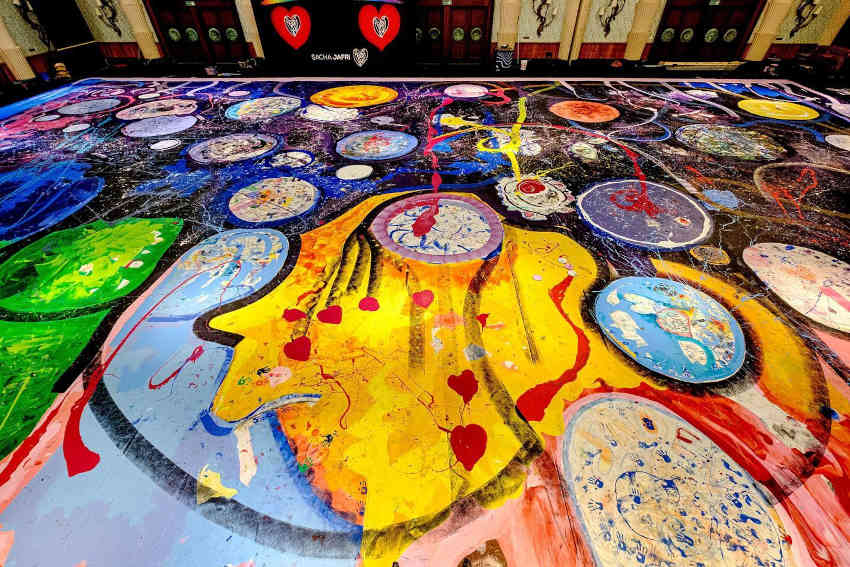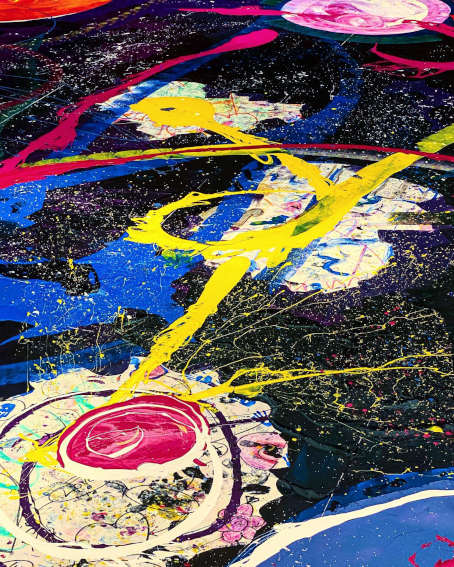
World's Largest Painting is Now Worth $62 Million!
Sacha Jafri made headlines this month when his painting “The Journey of Humanity” became the fourth most expensive artwork (and the most expensive abstract artwork) ever sold by a living artist. Measuring nearly 1600 square meters, the work is also the world’s largest painting (technically, the world’s “Largest Art Canvas”), as certified by the Guinness Book of World Records. Jafri originally hoped to raise $30 Million for charity by selling the painting in pieces over the course of four auctions. Instead, the painting sold in its entirety for $62 Million, to a single buyer—Andre Abdoune, the French born, Dubai-based CEO of crypto-investment firm Altius Gestion International Holding. Jafri has said he will donate the entire $62 Million, splitting it between Dubai Cares (an organization to remove barriers to quality education for children in developing nations); UNICEF (the United Nations International Children's Emergency Fund); UNESCO (the United Nations Educational, Scientific and Cultural Organization); and the Global Gift Foundation (founded by Spanish actress and businesswoman María Bravo to assist socially vulnerable children, women and families). Those already familiar with Jafri know that raising tens of millions of dollars to benefit disadvantaged children is nothing new for the artist. Over the course of his 20-year career, he has sold his paintings to some of the most famous people in the world, and donated about $60 Million to charity prior to this auction. For that, his importance as a cultural figure is undeniable. But since the job of an arts journalist is to think critically about what is going on behind the headlines, I nonetheless feel compelled to raise two questions about this story. The first is, “What about the art?” And the second is, “How far will $62 Million actually go towards making the world a better place?”
Size Matters
Visually, I would describe “The Journey of Humanity” as a kaleidoscopic, quasi-spiritual mishmash of lyrical abstract art history. Its swirling, gloopy layers read like part Hilma af Klint, part Jackson Pollock, part Joan Miró, and part kindergarten doodle. In a promotional video for the project, Jafri explains that the image consists of five parts: “soul of the earth, nature, the arrival of humanity (the journey of a child), the solar system, and the child's portal.” To make the painting, he first pasted down drawings sent to him by children all over the world depicting their feelings of isolation during the COVID-19 pandemic. He then laid down hundreds of gallons of paint, burning through hundreds of brushes and mobilizing every splashing, dripping, smearing, and paint throwing technique in the Abstract Expressionist playbook. As much as I admire what Jafri has accomplished philanthropically, I have mixed opinions about “The Journey of Humanity” as a painting. The image is unoffensive, even eye-catching at times, but the visual language is derivative. Its scale is really the only thing that makes it stand apart for me.

Sacha Jafri's The Journey of Humanity, detail. Courtesy the artist and Humanity Inspired
Georgia O’Keeffe thought a lot about scale on her journey towards becoming one of the most famous and influential painters ever. She variously explored abstraction, landscape and architectural paintings, but her depictions of giant flowers made her a legend. “I decided that if I could paint that flower in a huge scale, you could not ignore its beauty,” O’Keeffe said. She was not only interested in formal aesthetic issues—she wanted to inspire people with her art. Countless lesser painters have also tried to create images of beauty to share with the world, and failed simply because they were not very good painters. O’Keeffe achieved her altruistic goal because she combined it with a unique visual voice and a mastery of method, color, and composition. Like her, Jafri is trying to accomplish something idealistic with his art. He has said, “My dream is to reconnect the world in a meaningful way.” Yet, he has also said that he wants to be an influential artist—“the Kandinsky” of his generation. Achieving that will take more than scale, generosity, and a sense of the spiritual in art. At a minimum, Jafri will also need an aesthetic position that is original.
The $62 Million Question
Sixty-two million dollars is an impressive price tag for anything, let alone a single artwork. However, when it comes to achieving the goal Jafri has established of helping to create a safer, healthier, more just world for children, that money is going to run out fast. Consider just the economic cost of the ongoing wars in Yemen and Syria, two places where children are most in need today. The war in Yemen is estimated to have caused more than $14 Billion in damage and economic loss so far. The cost to rebuild Syria has been estimated at more than $388 Billion. For perspective, the Bill & Melinda Gates Foundation is currently worth $46.8 Billion. Novo Nordisk Foundation, the wealthiest philanthropic organization in the world, is worth $49.1 Billion.

Section from Sacha Jafri's The Journey of Humanity. Courtesy the artist and Humanity Inspired
It would take the entire combined net worth of the top ten philanthropic organizations in the world combined with the total wealth of the Mormon and Protestant Churches just to rebuild Syria. Then it would take the wealth of Saudi Aramco combined with the incalculable net worth of the global Catholic Church to begin to assuage the suffering caused by the more than 70 other conflicts currently unfolding around the world according to the International Crisis Group. In the face of such daunting statistics, how could anyone argue that is the responsibility of artists to make all of the broken communities of the world whole again? But then whose responsibility is it? Regardless of what anyone thinks about his paintings, I consider Jafri to be an important artist because he takes risks, and an important human for doing what is within his power to better the lives of children. What he really needs are more collaborators.
Featured image: Section from Sacha Jafri's The Journey of Humanity. Courtesy the artist and Humanity Inspired
All images used for illustrative purposes only
By Phillip Barcio






